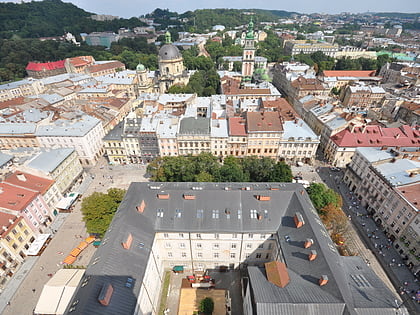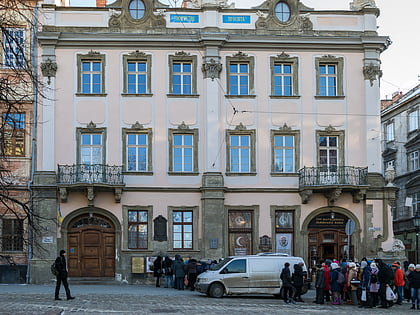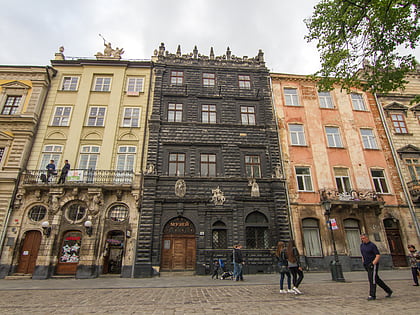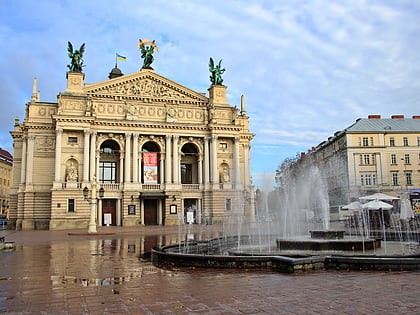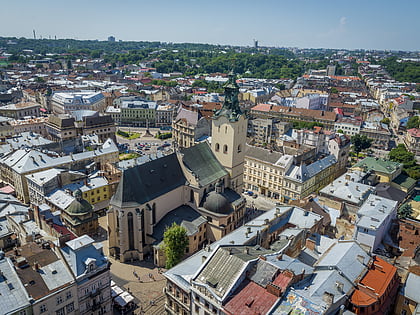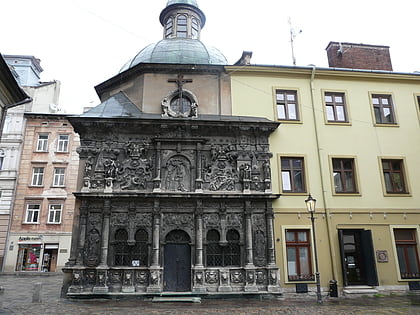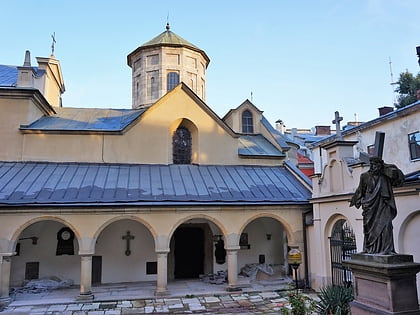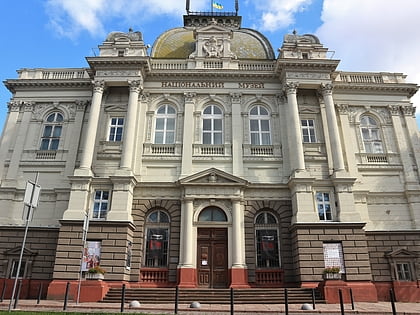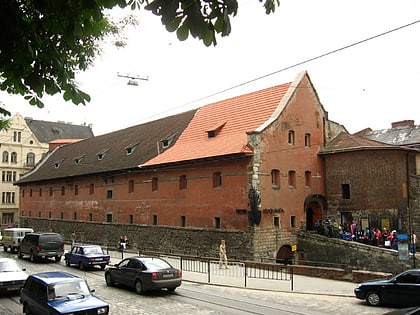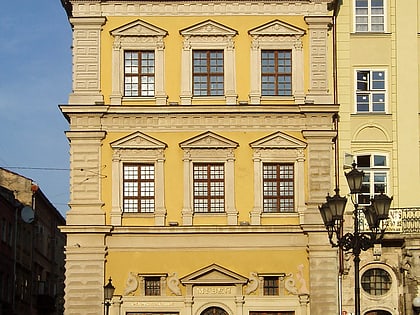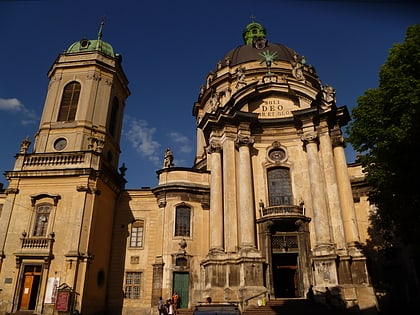Lvivskij muzej istorii religii, Lviv
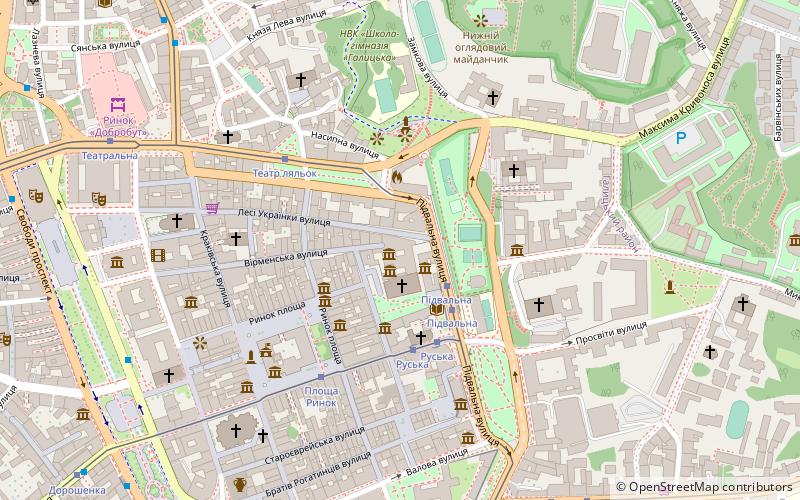

Facts and practical information
The Lviv Museum of Religion History is a cultural institution which, through its collection of unique materials, showcases the history of world and national religions and the activities of church organizations.
The museum is located in the cells of the former Dominican Monastery, built in the XIV - XVIII centuries. Organ music concerts, which are organized by the Department of Music and Education, are held in the large exhibition hall - the former refectory of the monastery.
The church was built according to the project of the Austrian engineer Jan Vit and belongs to the best examples of Baroque architecture in the city. The main vivtare was created in 1766 by the sculptor Sebastian Fesinger. Four wooden sculptures by Matviej Polejovsky depict John the Baptist, the apostles Peter and Paul and the evangelist Luke.
The exhibition consists of the following thematic sections: "Religion of the Old World", "Judaism", "Early Christianity", "The Roman Catholic Church", "History of the Roman Catholic Church", "Ukrainian Greek Catholic Church", "Orthodoxy in Ukraine", "Protestantism", "Islam", "Buddhism". The structure of the museum consists of departments: exhibition, scientific and educational, advertising, methodological, funds, publishing house "Logos", library, photo and holographic laboratories, scientific-restoration, art, biobibliography.
The collection has over 50 thousand items of preservation. Among them are exhibits of unique religious, artistic and historical value. For example, a large collection of XVI-XIX century icons includes a collection of Bibles, a reliquary of St. Antony of the XI century, and so on.
The museum holds regular international scientific conferences "History of Religions in Ukraine" and publishes their materials, as well as once every two years produces scientific almanacs dedicated to significant dates in the history of the church.
The museum offers its visitors various forms of scientific and educational work: lectures, excursions, organ and chamber music concerts, and consultations.
The Lviv Museum of Religious History has a specialized library of religious studies, which has no equivalent in our country. The 150,000 volumes include works by theologians of the Kiev, Lviv, St. Petersburg and Moscow theological academies as well as their periodicals, Catholic Institutes of Italy, Germany, Austria, France, and Poland, a collection of religious literature from the times of the Crimean Khanate, and the works of the Ukrainian Catholic University in Rome.
Most of the books in the library are in foreign languages The library has a rare collection of old Ukrainian books from the years 826-1910, as well as copies of the Catholic Encyclopedic and Orthodox Encyclopedias. The collection also includes rare books such as The Catholic Encyclopedia, The Encyclopedia of Orthodoxy, books by the Jagiellonian University in Cracow, German Lutheran books, and many others.The following editions were published: The Universe and the World, The Human Race, etc.; Brockhaus-Efron Encyclopedia; Encyclopedic Dictionary "Granat", pre-revolutionary editions "The Universe and the World", "Humanity", etc.; The French edition of Paris, Lyon.
The library has 300 books of Hebrew and Judaic literature. A large part of it consists of separate volumes of the Tenach, the Babylonian Talmud, the Sultan Aruch, prayer books, and Hebrew literature. Unique are the rare books "Mahzor. Holy Week Prayers, Mikraot Gdolot, and others. A large part of the book collection is taken up by old periodicals, which are considered rare: "The World of God, The Rest of the Christian, The World, Theological Thought, The Word of the Pastor, The Russian Pilgrim, The Old Believer Magazine, The Wanderer, the works of the Kiev Spiritual Academy; the Chernigov, Kiev diocesan newspapers, and others.
In addition, the collection contains publications of religious organizations of Galicia in the 20-30s, as well as Croatian and Czech books of the same period. The library collection contains unique collections of Bibles in various languages of the world: Greek, Latin, German, French, Chinese, English, etc.
Among them is the Ostrozka Bible of Ivan Fyodorov, a Parisian edition of 1563, a Venetian edition of the 16th century. The main group of books consists of the history of monasteries and churches, their statistical, theological, and historical analysis, as well as publications of the Lvov monasteries, the Kiev Pechersk Monastery, the Pochaiv Monastery, and the Mandrava monasteries. The library contains many books from the private libraries of prominent figures of the church, as their signatures and bookplates Peter Mohyla, Joseph Slipy, Klimentiy Sheptytsky attest. There are also editions of "Studion", fathers-vassilians from Zhovkva, collections of works of the National Scientific and Technical School in Lviv. The library's collection includes books from the Historical Library of the Stavropegic Institute.
The library contains a small, but unique in Ukraine, valuable collection of Arabic literature of the 16th-20th centuries, Koran, theological treatises, calendars, as well as works of religious figures in Persian, Turkish and Sanskrit. The library of the Museum of Religious History was formed from the beginning of its foundation in 1973. Some of the literature was given to the library by the Lviv History Museum, the Leningrad Museum of Religious History and Atheism as well as by scientific museum expeditions to Chita and Ulan-Ude. The Catholic Institute in Rome in the 1990s donated to the museums a 300-volume set of Religious and Religious Literature, as well as a library containing literature from private collections and the literature of the fathers of the CSVV. The library was constantly replenished with literature from the fund-raising committees and the exchange fund.
The museum has three branches: 1980 - the Chernograd branch, 1991 - the Sokal branch "People. Earth. World", 1993. - Institute of Religion and Science. 2009 - Museum garden of the Antonici family in Bortyatyni.
Lvivskij muzej istorii religii – popular in the area (distance from the attraction)
Nearby attractions include: Market, Lubomirski Palace, Black House, Lviv Theatre of Opera and Ballet.
Frequently Asked Questions (FAQ)
Which popular attractions are close to Lvivskij muzej istorii religii?
How to get to Lvivskij muzej istorii religii by public transport?
Tram
- Pidvalna str. (2 min walk)
- Rus'ka (3 min walk)
Bus
- Chornovola avenue • Lines: 111, 114, 121, 184а (12 min walk)
- Zernova • Lines: 111 (12 min walk)
Train
- Підзамче (14 min walk)

